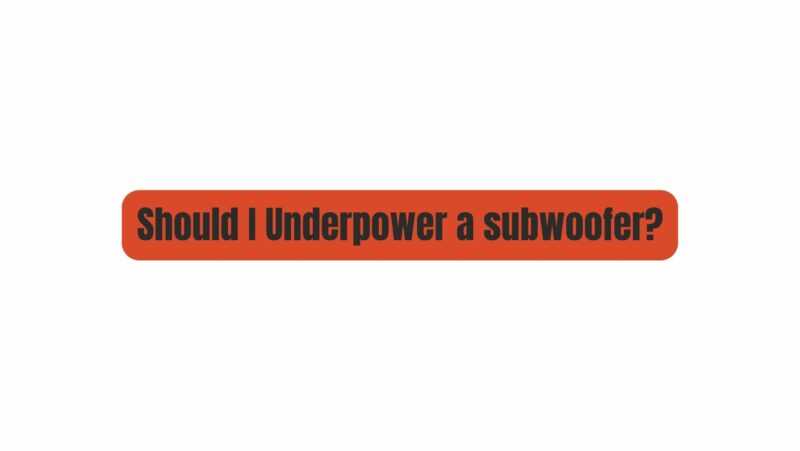Subwoofers are the powerhouse of the audio world, responsible for delivering those deep and thunderous bass notes that can make your audio experience truly immersive. However, when it comes to powering subwoofers, the question of whether to purposely underpower them often arises. In this comprehensive article, we will explore the concept of underpowering subwoofers, the reasons behind this practice, the potential benefits, drawbacks, and alternative approaches to achieving the perfect balance between audio performance and equipment health.
Understanding Subwoofer Power Handling
To make an informed decision about underpowering a subwoofer, it’s essential to understand the concept of subwoofer power handling. Power handling is a specification that indicates the amount of electrical power a subwoofer can handle continuously (RMS) without sustaining damage. Typically measured in watts, this specification helps users choose the right amplifier for their subwoofer.
When we discuss underpowering a subwoofer, we mean using an amplifier that delivers less power than the subwoofer’s RMS rating. Conversely, overpowering involves using an amplifier that provides more power than the subwoofer’s RMS rating.
The Case for Underpowering a Subwoofer
1. Enhanced Speaker Longevity:
One of the primary reasons for intentionally underpowering a subwoofer is to prioritize the longevity and health of the speaker. By using an amplifier that provides less power than the subwoofer’s RMS rating, you reduce the risk of immediate damage to the speaker due to overpowering.
2. Reduced Risk of Overheating:
An underpowered amplifier typically operates well below its maximum capacity, resulting in reduced heat generation. This can be particularly advantageous in situations where extended periods of use are expected, as it lowers the risk of overheating and amplifier protection circuitry activation.
3. Cost-Effective Approach:
If you already own an amplifier with lower power output, underpowering allows you to utilize your existing equipment without the need for additional investments in a more powerful amplifier. This can be a cost-effective way to achieve satisfactory bass performance.
The Drawbacks of Underpowering:
1. Reduced Output:
The most apparent drawback of underpowering a subwoofer is reduced output. An underpowered subwoofer driven by an amplifier that does not deliver enough power will not reach its full potential in terms of volume and impact. This can result in a less immersive audio experience, especially in larger spaces.
2. Potential for Distortion:
Underpowered subwoofers may push the amplifier to its limits when attempting to produce higher volume levels. This can lead to distortion, which is unpleasant and can negatively affect overall audio quality.
3. Inadequate Performance in Large Spaces:
In larger listening areas, underpowering a subwoofer may result in insufficient bass output to fill the space effectively. This can lead to a lackluster listening experience, particularly if the subwoofer struggles to reproduce deep bass frequencies.
Alternative Approaches to Speaker Protection
While underpowering is a valid approach to protect subwoofers, there are alternative methods to safeguarding your equipment while maintaining audio performance:
1. Proper Amplifier Matching:
Instead of deliberately underpowering, select an amplifier that closely matches the subwoofer’s RMS power handling capability. This ensures that you provide sufficient power for the subwoofer to perform optimally without the risk of overpowering.
2. Use a Limiter or Compression:
Employ signal processing tools such as limiters or compressors in your audio setup. These devices can help prevent excessive peaks in the audio signal, reducing the risk of overpowering and distortion.
3. Monitor Volume Levels:
Exercise caution when setting volume levels, and avoid pushing the audio system to its maximum limits. Being mindful of volume can prevent distortion and minimize the risk of overpowering.
4. Invest in Quality Amplification:
Consider investing in a high-quality amplifier with a reputable power rating. Quality amplifiers are less likely to introduce distortion, even at higher volumes.
Conclusion
In conclusion, the decision to intentionally underpower a subwoofer should be made with careful consideration of your priorities and constraints. While underpowering can enhance speaker longevity and minimize the risk of overheating, it comes at the cost of reduced bass output and potential distortion. Alternatives such as proper amplifier matching, signal processing tools, volume control, and quality amplification offer ways to protect your equipment while maintaining audio performance.
Ultimately, the goal is to achieve the perfect balance between audio quality and equipment health. Whether you choose to underpower or explore alternative approaches, the key is to ensure that your subwoofer delivers the deep, impactful bass that enhances your audio experience while safeguarding its long-term reliability.


